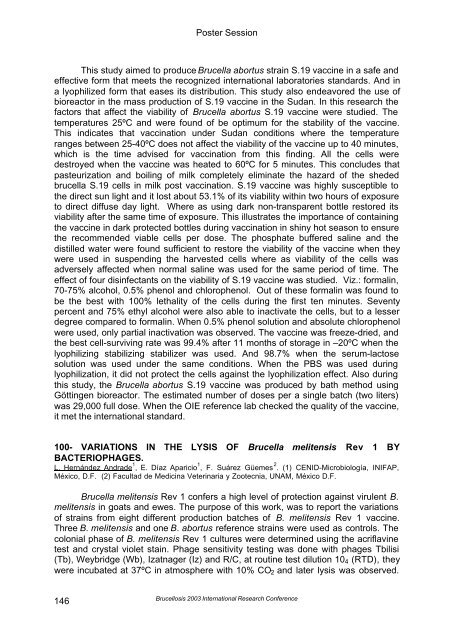Brucellosis 2003 proceedings - PHIDIAS
Brucellosis 2003 proceedings - PHIDIAS
Brucellosis 2003 proceedings - PHIDIAS
Create successful ePaper yourself
Turn your PDF publications into a flip-book with our unique Google optimized e-Paper software.
Poster Session<br />
This study aimed to produce Brucella abortus strain S.19 vaccine in a safe and<br />
effective form that meets the recognized international laboratories standards. And in<br />
a lyophilized form that eases its distribution. This study also endeavored the use of<br />
bioreactor in the mass production of S.19 vaccine in the Sudan. In this research the<br />
factors that affect the viability of Brucella abortus S.19 vaccine were studied. The<br />
temperatures 25ºC and were found of be optimum for the stability of the vaccine.<br />
This indicates that vaccination under Sudan conditions where the temperature<br />
ranges between 25-40ºC does not affect the viability of the vaccine up to 40 minutes,<br />
which is the time advised for vaccination from this finding. All the cells were<br />
destroyed when the vaccine was heated to 60ºC for 5 minutes. This concludes that<br />
pasteurization and boiling of milk completely eliminate the hazard of the sheded<br />
brucella S.19 cells in milk post vaccination. S.19 vaccine was highly susceptible to<br />
the direct sun light and it lost about 53.1% of its viability within two hours of exposure<br />
to direct diffuse day light. Where as using dark non-transparent bottle restored its<br />
viability after the same time of exposure. This illustrates the importance of containing<br />
the vaccine in dark protected bottles during vaccination in shiny hot season to ensure<br />
the recommended viable cells per dose. The phosphate buffered saline and the<br />
distilled water were found sufficient to restore the viability of the vaccine when they<br />
were used in suspending the harvested cells where as viability of the cells was<br />
adversely affected when normal saline was used for the same period of time. The<br />
effect of four disinfectants on the viability of S.19 vaccine was studied. Viz.: formalin,<br />
70-75% alcohol, 0.5% phenol and chlorophenol. Out of these formalin was found to<br />
be the best with 100% lethality of the cells during the first ten minutes. Seventy<br />
percent and 75% ethyl alcohol were also able to inactivate the cells, but to a lesser<br />
degree compared to formalin. When 0.5% phenol solution and absolute chlorophenol<br />
were used, only partial inactivation was observed. The vaccine was freeze-dried, and<br />
the best cell-surviving rate was 99.4% after 11 months of storage in –20ºC when the<br />
lyophilizing stabilizing stabilizer was used. And 98.7% when the serum-lactose<br />
solution was used under the same conditions. When the PBS was used during<br />
lyophilization, it did not protect the cells against the lyophilization effect. Also during<br />
this study, the Brucella abortus S.19 vaccine was produced by bath method using<br />
Göttingen bioreactor. The estimated number of doses per a single batch (two liters)<br />
was 29,000 full dose. When the OIE reference lab checked the quality of the vaccine,<br />
it met the international standard.<br />
100- VARIATIONS IN THE LYSIS OF Brucella melitensis Rev 1 BY<br />
BACTERIOPHAGES.<br />
L. Hernández Andrade 1 , E. Díaz Aparicio 1 , F. Suárez Güemes 2 . (1) CENID-Microbiología, INIFAP,<br />
México, D.F. (2) Facultad de Medicina Veterinaria y Zootecnia, UNAM, México D.F.<br />
Brucella melitensis Rev 1 confers a high level of protection against virulent B.<br />
melitensis in goats and ewes. The purpose of this work, was to report the variations<br />
of strains from eight different production batches of B. melitensis Rev 1 vaccine.<br />
Three B. melitensis and one B. abortus reference strains were used as controls. The<br />
colonial phase of B. melitensis Rev 1 cultures were determined using the acriflavine<br />
test and crystal violet stain. Phage sensitivity testing was done with phages Tbilisi<br />
(Tb), Weybridge (Wb), Izatnager (Iz) and R/C, at routine test dilution 10 4 (RTD), they<br />
were incubated at 37ºC in atmosphere with 10% CO 2 and later lysis was observed.<br />
146<br />
<strong>Brucellosis</strong> <strong>2003</strong> International Research Conference
















